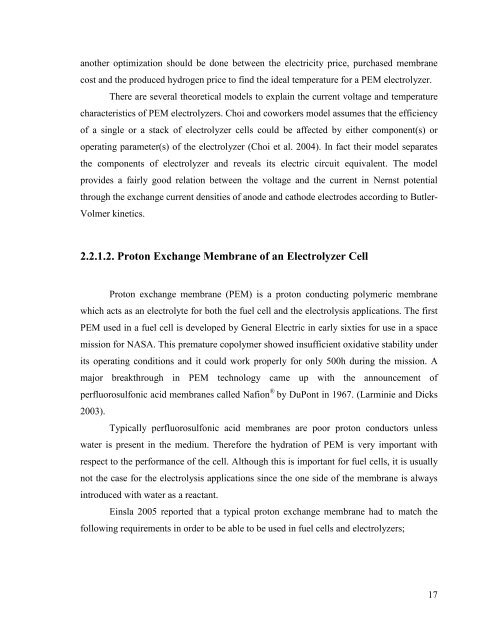hydrogen production from water using solar cells powered nafion ...
hydrogen production from water using solar cells powered nafion ...
hydrogen production from water using solar cells powered nafion ...
You also want an ePaper? Increase the reach of your titles
YUMPU automatically turns print PDFs into web optimized ePapers that Google loves.
another optimization should be done between the electricity price, purchased membrane<br />
cost and the produced <strong>hydrogen</strong> price to find the ideal temperature for a PEM electrolyzer.<br />
There are several theoretical models to explain the current voltage and temperature<br />
characteristics of PEM electrolyzers. Choi and coworkers model assumes that the efficiency<br />
of a single or a stack of electrolyzer <strong>cells</strong> could be affected by either component(s) or<br />
operating parameter(s) of the electrolyzer (Choi et al. 2004). In fact their model separates<br />
the components of electrolyzer and reveals its electric circuit equivalent. The model<br />
provides a fairly good relation between the voltage and the current in Nernst potential<br />
through the exchange current densities of anode and cathode electrodes according to Butler-<br />
Volmer kinetics.<br />
2.2.1.2. Proton Exchange Membrane of an Electrolyzer Cell<br />
Proton exchange membrane (PEM) is a proton conducting polymeric membrane<br />
which acts as an electrolyte for both the fuel cell and the electrolysis applications. The first<br />
PEM used in a fuel cell is developed by General Electric in early sixties for use in a space<br />
mission for NASA. This premature copolymer showed insufficient oxidative stability under<br />
its operating conditions and it could work properly for only 500h during the mission. A<br />
major breakthrough in PEM technology came up with the announcement of<br />
perfluorosulfonic acid membranes called Nafion ® by DuPont in 1967. (Larminie and Dicks<br />
2003).<br />
Typically perfluorosulfonic acid membranes are poor proton conductors unless<br />
<strong>water</strong> is present in the medium. Therefore the hydration of PEM is very important with<br />
respect to the performance of the cell. Although this is important for fuel <strong>cells</strong>, it is usually<br />
not the case for the electrolysis applications since the one side of the membrane is always<br />
introduced with <strong>water</strong> as a reactant.<br />
Einsla 2005 reported that a typical proton exchange membrane had to match the<br />
following requirements in order to be able to be used in fuel <strong>cells</strong> and electrolyzers;<br />
17

















